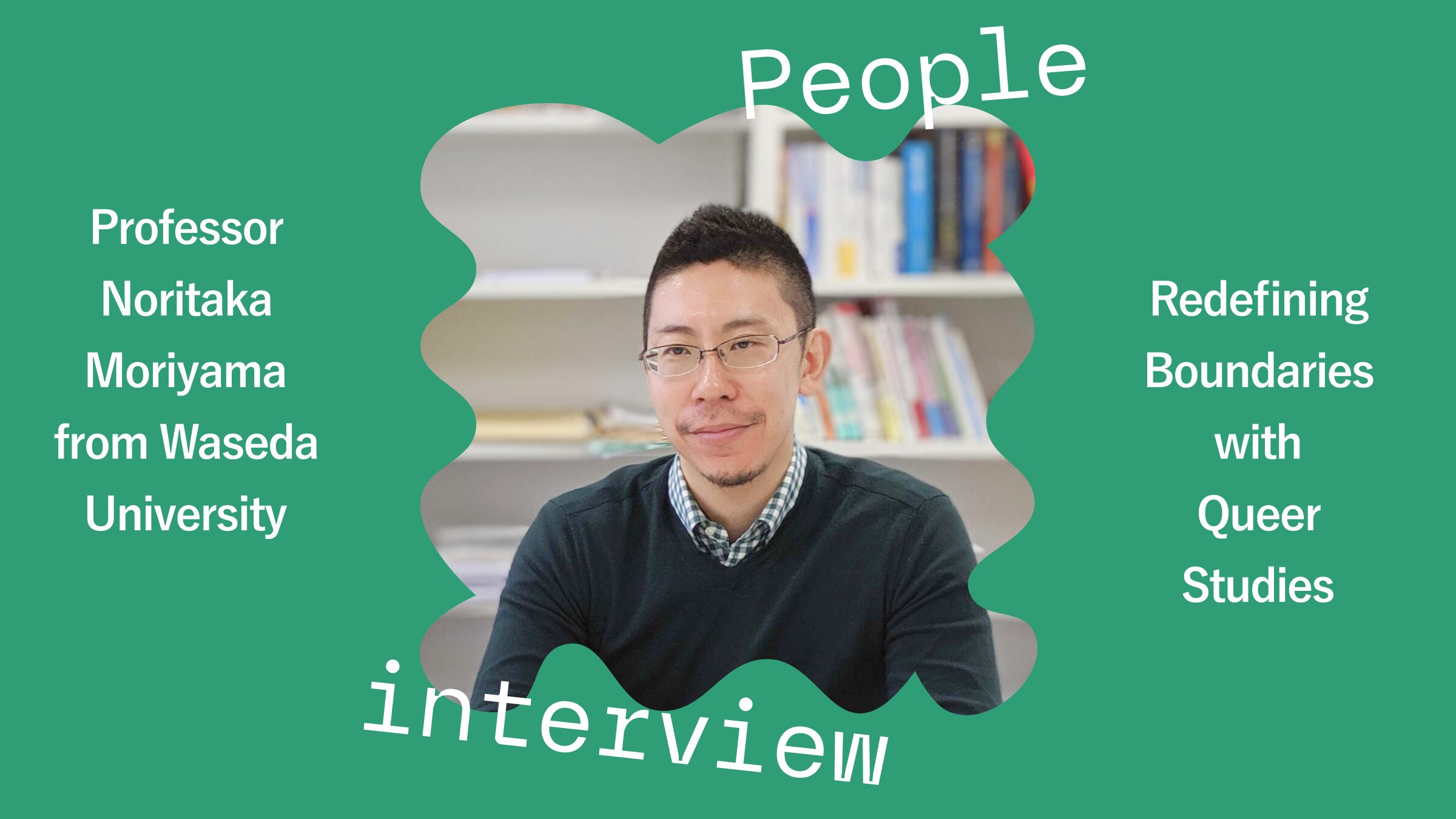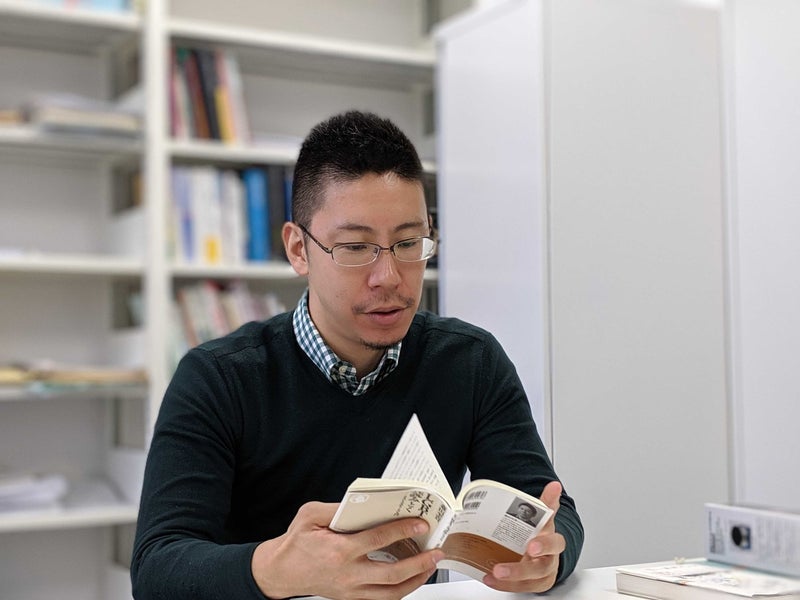【Interview】Redefining Boundaries with Queer Studies: Exploring the Meaning of Queer with Professor Noritaka Moriyama from Waseda University’s Gender Research Institute

Have you ever heard of the word “queer”?
Originally, “queer” means “unusual” or “strange” in English. However, this word has a history of being used as a derogatory term for LGBTQ+ individuals.
On the other hand, in recent years, you might have come across the word “queer” being used in a different context. For instance, there’s the show “Queer Eye” on Netflix. It’s a reality show where five stylish gay men help people transform their lives.
Even in universities, alongside Gender Studies and Feminism, “queer” has become a theme in classes, making it a more common term. You might have also noticed more people adding the word “queer” to their social media profiles.
However, compared to the broader recognition of the term LGBTQ+, not many people truly understand the meaning of “queer.”
So, this time, we visited Professor Noritaka Moriyama’s research lab at Waseda University to learn about the history and meaning of the word “queer” and Queer Studies.
(Written by: Mari Ito)
Ito: Recently, a version of “Queer Eye” set in Japan was released on Netflix. This reality show features five gay men helping people transform their lifestyles. But I heard that the word “queer” itself has a negative meaning.
Moriyama: Yes. The word “queer” has historically been used as a derogatory term for transgender women and gay men. If we were to translate it, it would mean something like “pervert.”
Ito: Pervert… Is it similar to the Japanese terms “okama” or “homo”?
Moriyama: That’s right. But recently, I’ve noticed that individuals within the LGBTQ+ community intentionally self-identify as “queer.”
Ito: So, it’s being used in a positive sense, not as an insult?

Moriyama: Yes. By deliberately using a term with derogatory undertones as a self-identifier, they are resisting being negatively labeled by the majority. They are saying that they define their own existence, not the majority. I
Ito: This reminds me of the “Pussy Hat” worn during the Women’s March. It’s like the word “pussy,” which has been used disrespectfully towards women, is being reclaimed by women themselves as a symbol of empowerment.
*The “Pussy Hat” is a pink knitted hat with a cat-like design. It plays on the double meaning of the word “pussy,” which can refer to both a woman’s genitals and a derogatory term for women. The hat became a symbol during the 2017 Women’s March and protests against the inauguration of President Trump. Many participants wore the Pussy Hat to demonstrate against his disrespectful comments about women, specifically his statement that being famous allows him to do whatever he wants with women.
Moriyama: Absolutely! The movement to reclaim the right to define their identity is quite common in minority movements. Queer Studies itself also inherits many theories from feminism, so having such commonalities is natural, I believe.
Ito: So, the term “queer” in “Queer Eye” carries a positive meaning after resistance against discrimination.
Moriyama: In this case, “queer” specifically refers to gay men. The show features five gay men. However, “queer” doesn’t only apply to gay men.
Ito: Oh, really?
Moriyama: The word “queer” can refer to gay men, but it can also encompass sexual minorities as a whole. It’s used when highlighting sexualities beyond “LGBT” as well.

Ito: Is it the Q+ part when we say LGBTQ+?
Moriyama: Exactly. “LGBT” stands for Lesbian, Gay, Bisexual, and Transgender, but there are many other sexualities that have been recognized for a long time. For instance, there’s “gender fluid,” where gender identity is not fixed, or “aromantic,” which means not experiencing romantic attraction. “Queer” is a word that aims to shed light on sexualities that might be left out by the “LGBT” label.
Ito: I see, so it’s not clearly defined in one specific meaning. The term “queer” itself seems to challenge the notion of what’s considered “normal” in terms of sexuality.
Moriyama: It’s used flexibly based on the context and need. The academic field of Queer Studies has the purpose of reevaluating the boundaries between “normal” and “abnormal” and even criticizing the structure of categorizing things into “normal” and “abnormal.”
Ito: Indeed, the norm of “normalcy” can create pressure. Those who don’t fit the norm might be excluded or feel discomforted by being labeled as “not normal” or “abnormal.”
Moriyama: Yes. In today’s society, being “cisgender and heterosexual” is considered normal. But beyond that, things like “getting married” or “having children” also function as “normal” in this society.

Moriyama: Actually, this is something very familiar to students. The atmosphere of “you have to be in a romantic relationship!” or “it’s strange if you don’t have a partner!” is deeply ingrained. So, many students are troubled by the idea that “maybe it’s weird not to be in a romantic relationship.”
Ito: True, I remember there being pressure to be in a romantic relationship when I was a student.
Moriyama: It’s not just for aromantic or asexual students, but also for those who say “I’m not interested in romance right now” or “I don’t want to get married.” They face strong pressure too. That’s why it’s important to convey that “there’s diversity in sexuality beyond ‘LGBT'” and to rethink the framework of “normal.”
Ito: So, even beyond what’s called “LGBT,” there are many people who need Queer Studies. Has the movement to question the “normal/abnormal” framework been around for a long time?
Moriyama: I want to say it has, but I also have to admit that it’s been incomplete in many ways. For example, the social movements by homosexuals in the United States until around the 1950s strongly emphasized the message “gay people are just like ‘normal’ people.” Assimilation was encouraged.
Ito: So, there was an aspect of the movement aiming to be accepted by the majority, where everything except sexual orientation is considered “normal”?
Moriyama: Yes. A change began after events like the Stonewall riots in 1969. These events marked the start of the so-called gay liberation movement. This movement valued the identity of being “gay or lesbian” and no longer aimed to assimilate into the “normal = heterosexual” value.
Ito: Within the transgender movement, have there been discussions about questioning the boundaries of “normal/abnormal”?
Moriyama: In the 1950s, people who underwent gender confirmation surgeries believed that by doing so, they could become “normal” heterosexual individuals. Even now, there’s sometimes an understanding that transgender individuals who’ve undergone surgery to “return to normal” from being born in the “wrong” body.
Ito: I See.
Moriyama: Of course, even among the individuals themselves, some feel that way. There are those who don’t want their past mentioned because they lived in a body different from their gender identity. On the other hand, there are transgender individuals who value their identity, including their past. Regardless, what should be respected is the individual’s wishes, and it seems violent for others to arbitrarily declare that someone has “returned to normal.”
Ito: As long as the authority to define what’s “normal” rests with the majority, there will always be someone being judged. We need to deconstruct the relationship of “normal/abnormal.”
Moriyama: Yes. In Queer Studies, it is very important to be able to doubt what is said in words such as “normal/abnormal”.

Ito: Even in movements trying to exclude transgender women on social media, we see situations where someone else arbitrarily judges and decides whether they’re “normal women.”
Moriyama: The moment we rely on the word “normal,” we might exclude someone. It’s something we always need to be conscious of. Feminism has always challenged the norm that says “if you meet these conditions, you’re a woman.”
In the society we live in, there are plenty of “normals”. These range from small things like “normal to brush your teeth before bed” to things that could deny someone’s way of living.
For instance, the “normal” is to live according to the gender assigned at birth, fall in love with the opposite sex, get married, engage in sexual activities, and have children.
Even within this common life course, many other “normals” sneak in.
“Girls should be graceful.”
“By the time you’re 20, you should have one or two lovers.”
“Eventually, everyone should get married and start a family.”
“Having a certain number of children is the key to happiness.”
From each of these, society makes judgments like “not normal = abnormal” about someone.
So, where exactly is the boundary between “normal” and “not normal”? Who decides it? There, we might find people with the power to decide and others whose power has been taken away.
When we try to go beyond various “should be like this” that hinder someone’s choices and freedom of life, it’s important to focus on the power dynamics. Understanding the meaning of the word “queer” allowed us to realize the significance of this.
For those who want to learn more about Queer Studies, we recommend the following:
“Reading LGBT: An Introduction to Queer Studies” by Noritaka Moriyama, published by Chikuma Shobo in 2017.
In the book “Understanding LGBTQ+ Through Manga” (Kodansha) by Palettalk, you’ll find explanations from Professor Moriyama, who kindly provided insights in this interview. This book not only covers “LGBT” but also explains different sexualities in an easy-to-understand way using manga and references. Your support is greatly appreciated.
(Translation: Jennifer Martin)
